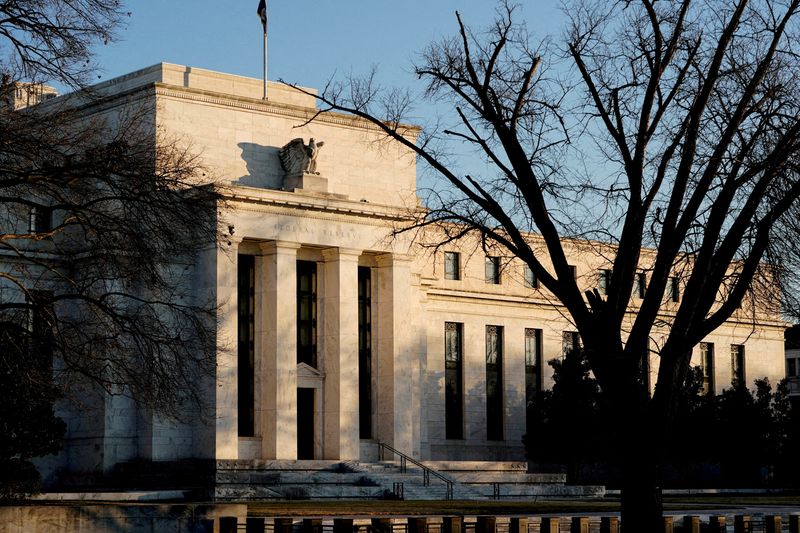(Reuters) – The labels “dove” and “hawk” have long been used by central bank watchers to describe the monetary policy leanings of policymakers, with a dove more focused on risks to the labor market and a hawk more focused on the threat of inflation.
The topsy-turvy economic environment of the coronavirus pandemic sidelined those differences, turning U.S. Federal Reserve officials at first universally dovish as they sought to provide massive accommodation for a cratering economy, and then, when inflation surged, into hawks who uniformly backed aggressive interest rate hikes.
Now, as Fed policymakers note an improvement on inflation and some cooling in the labor market, the risks are seen as more balanced and the choices more nuanced.
All 12 regional Fed presidents discuss and debate monetary policy at Federal Open Market Committee (FOMC) meetings that are held eight times a year, but only five cast votes at any given meeting, including the New York Fed president and four others who vote for one year at a time on a rotating schedule.
The following chart offers a look at how officials view the outlook for Fed policy and how best to balance their goals of stable prices and full employment. The designations are based on comments and published remarks; for more on the thinking that shaped these hawk-dove designations, click on the photos in this graphic.
Reuters over time has shifted policymaker designations based on fresh comments and developing circumstances – for an accounting of how our counts have changed, please scroll to the bottom of this story.
Dove Dovish Centrist Hawkish Hawk
Raphael Jerome Loretta Michelle
Bostic, Powell, Fed Mester, Bowman,
Atlanta Chair, Cleveland Governor,
Fed permanent Fed permanent
President, voter: “Decl President voter:”Whi
2024 aring , 2024 le the
voter: “If victory voter: current
we would be “March is stance of
continue premature probably monetary
to see a … But of too early policy
further course the in my appears to
accumulati question is estimatio be
on of when will it n for a sufficient
downside become rate ly
surprises appropriate decline.” restrictiv
in the to begin Jan. 11, e … I
data it’s dialing 2024 remain
possible back?” Dec. willing to
for me to 13, 2023 raise the
get federal
comfortabl funds rate
e to further at
advocate a future
normalizat meeting.”
ion sooner Jan. 8,
than the 2024
third
quarter.
But the
evidence
would need
to be
convincing
.” Jan.
18, 2024
Patrick John Thomas
Harker, Williams, Barkin,
Philadelph New York Fed Richmond
ia Fed President, Fed
President, permanent President
2026 voter: “It , 2024
voter: will only be voter: “G
“It’s appropriate etting
important to dial back inflation
that we the degree under
start to of policy control
move rates restraint is
down … when we are criticall
we don’t confident y
have to do that important
it too inflation is .” Jan.
fast, moving 5, 2024
we’re not toward 2% on
going to a sustained
do it basis.” Jan.
right 10, 2024
away, it’s
going to
take some
time.”
Dec. 20,
2023
Philip Lorie
Jefferson, Logan,
Vice Chair: Dallas
“We are in a Fed
sensitive President
period of , 2026
risk voter:
management, “We
where we shouldn’t
have to take the
balance the possibili
risk of not ty of
having another
tightened rate
enough, increase
against the off the
risk of table
policy being just
too yet.”
restrictive. Jan. 6,
” Oct. 9, 2024
2023
Christopher Neel
Waller, Kashkari,
Governor, Minneapol
permanent is Fed
voter: “The President
key thing is , 2026
the economy voter:
is doing “When
well. It is activity
giving us continues
the to run
flexibility this hot,
to move that
carefully makes me
and question
methodically if policy
.” Jan. 16, is as
2024 tight as
we assume
it
currently
is.” Nov.
7, 2023
Michael
Barr, Vice
Chair of
Supervision,
permanent
voter: The
Fed is “at
or near the
peak” of
interest
rates.” Nov.
17, 2023
Lisa Cook,
Governor,
permanent
voter: “I
see risks as
two-sided,
requiring us
to balance
the risk of
not
tightening
enough
against the
risk of
tightening
too much.”
Nov. 16,
2023
Mary Daly,
San
Francisco
Fed
President,
2024
voter: “It
takes
patience. It
takes
gradualism.”
Jan. 19,
2024
Austan
Goolsbee,
Chicago Fed
President,
2025
voter: “If
we continue
to make
surprising
progress,
faster than
was
forecast, on
inflation,
then we have
to take that
into account
in
determining
the level of
restrictiven
ess … but
we don’t
want to
commit
ourselves
before the
job is
done.” Jan.
19, 2024
Susan
Collins,
Boston Fed
President,
2025 voter:
The Fed
should be
“patient and
resolute,
and I
wouldn’t
take
additional
firming off
the table.”
Nov. 17,
2023
Note: Fed policymakers began raising interest rates in March 2022 to bring down high inflation. Their most recent policy rate hike, to a range of 5.25%-5.50%, occurred last July. Projections released on Dec. 13 showed no policymakers believe rates should go any higher this year, and a majority see them dropping by at least 75 basis points. Three policymakers – Fed Board Governor Adriana Kugler, Kansas City Fed President Jeffrey Schmid, and Alberto Musalem, who starts as the St. Louis Fed’s president on April 2 – have not made any substantive policy remarks and are not included in the dove-hawk matrix.
Below is a Reuters count of policymakers in each category, heading into recent Fed meetings.
FOMC Date Dove Dovish Centrist Hawkish Hawk
Jan ’24 0 2 9 4 1
Dec ’23 0 2 9 4 1
Oct/Nov ’23 0 2 7 5 2
Sept ’23 0 4 3 6 3
June ’23 0 3 3 8 3
March ’23 0 2 3 10 2
Dec ’22 0 4 1 12 2
(Reporting by Ann Saphir; Editing by Paul Simao)
